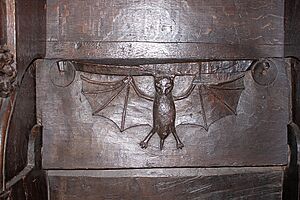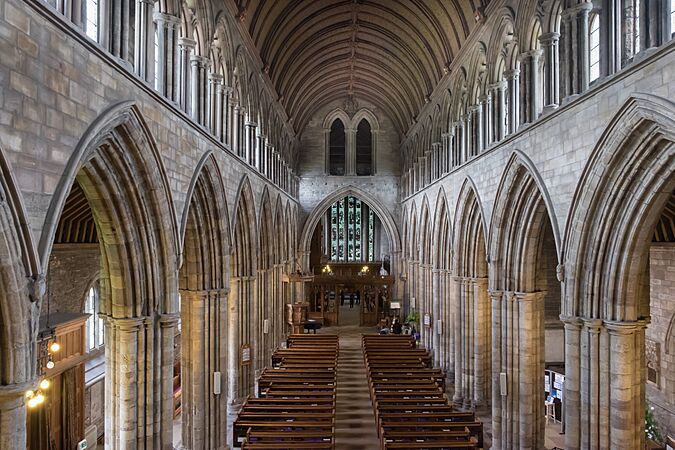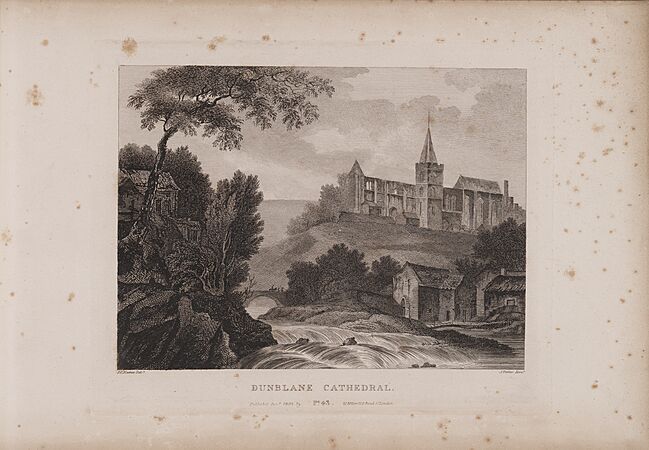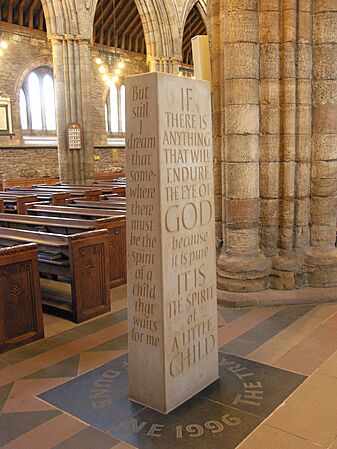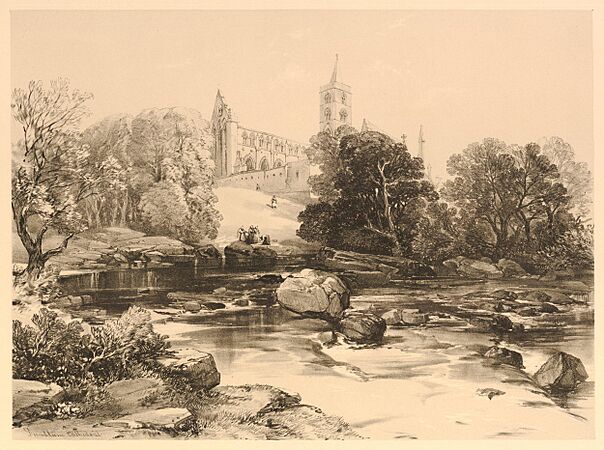Dunblane Cathedral facts for kids
Quick facts for kids Dunblane Cathedral |
|
|---|---|
| Cathedral Church of St Blaan and St Laurence | |

Dunblane Cathedral in 2017
|
|
| Lua error in Module:Location_map at line 420: attempt to index field 'wikibase' (a nil value). | |
| Country | United Kingdom |
| Denomination | Church of Scotland |
| Previous denomination | Roman Catholic |
| Membership | 697 |
| History | |
| Status | Parish church |
| Founded | c. 7th century (site) |
| Founder(s) | Saint Blane |
| Architecture | |
| Functional status | Active |
| Architect(s) | Robert Rowand Anderson (restoration) |
| Style | Gothic (mostly) |
| Years built | 11th to 15th century 1889 (restoration) |
| Specifications | |
| Number of towers | 1 |
| Tower height | Six storeys |
| Administration | |
| Presbytery | Stirling |
Dunblane Cathedral is a very old and important church in Dunblane, a town near Stirling in central Scotland. It is one of two Church of Scotland churches in the area.
The bottom part of its tower is super old, built around the 11th century. It used to stand by itself! The top part of the tower was added later, in the 15th century. Most of the rest of the building was built in the 13th century in a style called Gothic architecture. The church was fixed up and its main roof was replaced between 1889 and 1893 by an architect named Robert Rowand Anderson.
Contents
History of Dunblane Cathedral
The church is named after a 6th-century saint called St Blane. That's how the town of Dunblane got its name, meaning "hill of St Blane." The church also had a special altar for Saint Lawrence. The oldest part you can still see today is the lower four floors of the tower, which are from about 1100 AD. The top two floors of the tower were added around 1500.
This cathedral was once the main church for the Bishop of Dunblane. Bishops were leaders in the church. But after a big change in Scotland in 1689, bishops were no longer part of the Church of Scotland. This church is now a Presbyterian church, which means it doesn't have bishops. So, even though it's called a cathedral, it's technically a parish church today.
After bishops were removed, the main part of the church (the choir) became the local parish church. But the front part (the nave) wasn't used and its roof fell in around 1600.
The cathedral holds the graves of Margaret Drummond and her two sisters. They were connected to King James IV of Scotland and are said to have died under mysterious circumstances.
It's interesting that the building is owned by the Scottish government, not the church itself. Historic Scotland looks after it, and you don't have to pay to go inside!
The building is mostly from the 13th century. However, it includes an older bell-tower from the 11th century on its south side. This tower was made taller in the 15th century. You can actually see the difference in the stone color and the style of the windows at the top!
The choir section is from the 13th century. It has a long room next to it that was used as a meeting room for church leaders and a place to keep church items. The choir also has the tomb of the church's founder, Bishop Clement. Many of the wooden seats from the 15th century are still there. These seats have special carvings underneath called misericords. One even shows a bat! There are also more fancy seats at the west end of the church. Dunblane has the largest collection of medieval Scottish church woodwork after King's College Chapel, Aberdeen. Some smaller pieces are shown in the town's museum.
The cathedral was fixed up again in the late 1800s. The work was finished by Sir Robert Lorimer in 1912.
In June 2024, Dunblane Cathedral joined with two other local churches. It is now known as Dunblane Cathedral, Kilmadock and Blair Drummond Church.
Beautiful Stained Glass Windows
Dunblane Cathedral has many amazing stained glass windows. Each one tells a story or remembers someone special.
- West window: This window shows the Tree of Jesse. It was put in by Robert Younger, Baron Blanesburgh in 1906.
- Baptismal window: Above the font, this window shows John the Baptist in the River Jordan. It was made by Douglas Strachan in 1926.
- Window over south-west door: This window shows St George and Hope. It was put in in 1915 to remember a church elder.
- The Barty window: This window shows scenes from the Song of Solomon. It was put up in 1917.
- The Apostles (south-east corner): This window remembers Mr and Mrs Wallace.
- John the Baptist and the Good Shepherd (south-east corner): This window remembers Rev Dr Henry M Hamilton.
- Main East Window (choir): This large window shows the Life of Christ. It was put in in 1901 to remember John Alexander Hay.
- South window (choir): This window shows the Three Holy Children from the Book of Daniel. It was given by Robert Younger, Baron Blanesburgh.
- Allegory window (choir): This window shows four angels pointing in four directions.
- Chaos window (choir): This unusual window shows Scott's difficult journey to the South Pole and names the five men who died.
- The Earth window (choir)
- The Humanity window (choir): This window shows Adam and Eve with Cain and Abel.
- Memorial window (Lady Chapel): This window shows St Blane and a Crusader, plus Bishop Maurice and a soldier from World War I. It was made by Douglas Strachan.
- The Lord's Supper (Lady Chapel): Also by Douglas Strachan.
- The Healing of the Sick (Lady Chapel): Another window by Douglas Strachan.
- The Transfiguration (Lady Chapel): By Gordon Webster.
- Christ justifying harvesting on the Sabbath (Lady Chapel): By Gordon Webster.
- Christ on the Sea of Galilee (Lady Chapel): By Gordon Webster.
- Ruskin window (over west door): You can only see this window from outside!
Important Burials and Memorials
Inside the church, there are two very old Christian stones. These are from an even earlier church that stood on this spot.
The churchyard also has two graves from World War I. One is for William Stirling, a gunner in the Royal Marine Artillery.
Notable People Buried Here
Many important people are buried at Dunblane Cathedral, including:
- Bishop Clement of Dunblane (died 1258)
- Malise II, Earl of Strathearn (died 1271)
- The Three Drummond Sisters (16th century)
- Rev James Finlayson (1758-1808), a church minister and writer
- Sir David Russell (1809-1884)
- James Stirling (1690-1770), a mathematician
- John Stirling of Kippendavie (died 1812)
- Jane Stirling (1804-1859), a pianist
The Dunblane Commemoration Stone
In the main part of the cathedral, there is a special stone sculpture by Richard Kindersley. This stone remembers the very sad events of March 13, 1996. The stone has quotes from different writers that speak about children.
Other Churches in Dunblane
Dunblane Cathedral is just one of many churches in the town. There are at least seven others!
- St Blane's (another Church of Scotland church, also named after the town's founder)
- St Mary's (a Scottish Episcopal Church)
- Dunblane Free Church of Scotland
- The Roman Catholic Church of the Holy Family
- The Quaker Meeting House
- The Dunblane Christian Fellowship (an independent Evangelical church)
- The Eastern Orthodox church of Saint Nicholas (this community follows an older calendar)
Famous People and Events
- Ministers: Many important ministers have served here, including Michael Potter and James Pearson. Also, The Very Rev James Cockburn and John Rodger Gray were both Moderators of the General Assembly of the Church of Scotland.
- Weddings: In April 2015, famous tennis player Andy Murray, who grew up in Dunblane, married his partner Kim Sears in a private ceremony at the cathedral.
Gallery
-
The main part of the church (the nave) looking east.
See also
 In Spanish: Catedral de Dunblane para niños
In Spanish: Catedral de Dunblane para niños


